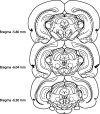Paradoxical facilitation of object recognition memory after infusion of scopolamine into perirhinal cortex: implications for cholinergic system function
- PMID: 16971536
- PMCID: PMC6674588
- DOI: 10.1523/JNEUROSCI.2319-06.2006
Paradoxical facilitation of object recognition memory after infusion of scopolamine into perirhinal cortex: implications for cholinergic system function
Abstract
The cholinergic system has long been implicated in learning and memory, yet its specific function remains unclear. In the present study, we investigated the role of cortical acetylcholine in a rodent model of declarative memory by infusing the cholinergic muscarinic receptor antagonist scopolamine into the rat perirhinal cortex during different stages (encoding, storage/consolidation, and retrieval) of the spontaneous object recognition task. Presample infusions of scopolamine significantly impaired object recognition compared with performance of the same group of rats on saline trials; this result is consistent with previous reports supporting a role for perirhinal acetylcholine in object information acquisition. Scopolamine infusions directly before the retrieval stage had no discernible effect on object recognition. However, postsample infusions of scopolamine with sample-to-infusion delays of up to 20 h significantly facilitated performance relative to postsample saline infusion trials. Additional analysis suggested that the infusion episode could cause retroactive or proactive interference with the sample object trace and that scopolamine blocked the acquisition of this interfering information, thereby facilitating recognition memory. This is, to our knowledge, the first example of improved recognition memory after administration of scopolamine. The overall pattern of results is inconsistent with a direct role for cortical acetylcholine in declarative memory consolidation or retrieval. Rather, the cholinergic input to the perirhinal cortex may facilitate acquisition by enhancing the cortical processing of incoming stimulus information.
Figures







Similar articles
-
What pharmacological interventions indicate concerning the role of the perirhinal cortex in recognition memory.Neuropsychologia. 2012 Nov;50(13):3122-40. doi: 10.1016/j.neuropsychologia.2012.07.034. Epub 2012 Jul 27. Neuropsychologia. 2012. PMID: 22841990 Free PMC article. Review.
-
Cholinergic manipulations bidirectionally regulate object memory destabilization.Learn Mem. 2015 Mar 16;22(4):203-14. doi: 10.1101/lm.037713.114. Print 2015 Apr. Learn Mem. 2015. PMID: 25776038 Free PMC article.
-
Scopolamine infused into perirhinal cortex improves object recognition memory by blocking the acquisition of interfering object information.Learn Mem. 2007 Sep 5;14(9):590-6. doi: 10.1101/lm.634607. Print 2007 Sep. Learn Mem. 2007. PMID: 17823242 Free PMC article.
-
Differing time dependencies of object recognition memory impairments produced by nicotinic and muscarinic cholinergic antagonism in perirhinal cortex.Learn Mem. 2011 Jun 21;18(7):484-92. doi: 10.1101/lm.2274911. Print 2011. Learn Mem. 2011. PMID: 21693636 Free PMC article.
-
Object recognition memory: neurobiological mechanisms of encoding, consolidation and retrieval.Neurosci Biobehav Rev. 2008 Jul;32(5):1055-70. doi: 10.1016/j.neubiorev.2008.04.004. Epub 2008 Apr 24. Neurosci Biobehav Rev. 2008. PMID: 18499253 Review.
Cited by
-
Muscarinic receptors modulate the intrinsic excitability of infralimbic neurons and consolidation of fear extinction.Neuropsychopharmacology. 2012 Aug;37(9):2047-56. doi: 10.1038/npp.2012.52. Epub 2012 Apr 18. Neuropsychopharmacology. 2012. PMID: 22510723 Free PMC article.
-
Septal cholinergic input to CA2 hippocampal region controls social novelty discrimination via nicotinic receptor-mediated disinhibition.Elife. 2021 Oct 26;10:e65580. doi: 10.7554/eLife.65580. Elife. 2021. PMID: 34696824 Free PMC article.
-
What pharmacological interventions indicate concerning the role of the perirhinal cortex in recognition memory.Neuropsychologia. 2012 Nov;50(13):3122-40. doi: 10.1016/j.neuropsychologia.2012.07.034. Epub 2012 Jul 27. Neuropsychologia. 2012. PMID: 22841990 Free PMC article. Review.
-
Adult hippocampal neurogenesis and its role in cognition.Wiley Interdiscip Rev Cogn Sci. 2014 Sep;5(5):573-587. doi: 10.1002/wcs.1304. Epub 2014 Aug 12. Wiley Interdiscip Rev Cogn Sci. 2014. PMID: 26308746 Free PMC article.
-
Cholinergic manipulations bidirectionally regulate object memory destabilization.Learn Mem. 2015 Mar 16;22(4):203-14. doi: 10.1101/lm.037713.114. Print 2015 Apr. Learn Mem. 2015. PMID: 25776038 Free PMC article.
References
-
- Abe H, Ishida Y, Iwasaki T. Perirhinal N-methyl-d-aspartate and muscarinic systems participate in object recognition in rats. Neurosci Lett. 2004;356:191–194. - PubMed
-
- Aigner TG, Mishkin M. The effects of physostigmine and scopolamine on recognition memory in monkeys. Behav Neural Biol. 1986;45:81–87. - PubMed
-
- Aigner TG, Walker DL, Mishkin M. Comparison of the effects of scopolamine administered before and after acquisition in a test of visual recognition memory in monkeys. Behav Neural Biol. 1991;55:61–67. - PubMed
-
- Bartus RT. On neurodegenerative diseases, models, and treatment strategies: lessons learned and lessons forgotten a generation following the cholinergic hypothesis. Exp Neurol. 2000;163:495–529. - PubMed
-
- Bartus RT, Dean RL, Pontecorvo MJ, Flicker C. The cholinergic hypothesis: a historical overview, current perspective, and future directions. Ann NY Acad Sci. 1985;444:332–358. - PubMed
Publication types
MeSH terms
Substances
Grants and funding
LinkOut - more resources
Full Text Sources
